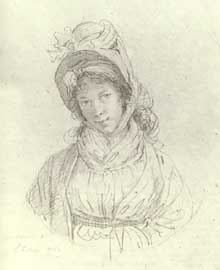 From The Pierpont Morgan Library, NY |
The Library's portrait, executed in pencil on blue notepaper, was undoubt- edly taken on the spot. As to when and for whom the artist made this souvenir of her friendship, therc is no clue. Her circumspcct inscription is a basis only for tantalizing speculation. The simplicity of Mme Le Brun's costume is in accord with a statement in her memoirs, published in 1835 when she was eighty: "I have always lived very modestly. I spent very little on clothes. In this respect, I was even accused of being too careless, for I always wore white dresses of muslin or linen and never had any ornamental dresses made except for my sittings at Versailles. My head-gear never cost me anything. I did my own hairdressing and generally twisted a muslin fichu about my head" This somewhat individual attitude toward fashion makes it difficult to date the drawing by the simple dress with a fichu filling the low, rounded neckline and the high waist, which are of the 1790S. The becoming high bonnet, on the other hand, conforms to the trend offashion after the turn of the century; yet there is nothing in this self-portrait to suggest the age of forty-five, which she reached in 1800. At most we can say that it was probably during her extended travels in Italy, Austria, and Russia that the painter made this charming likeness. Whatever the occasion, it was one that evoked her best efforts in a crisply penciled self-delineation that foreshadows the great exploiter of the pencil portrait, Ingres. From the Catalog FRENCH MASTER DRAWINGS From the Pierpont Morgan Library Cara Dufour Denison 1993 |
|
Vigée Le Brun's Home Page | Special Galleries |
